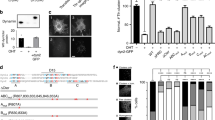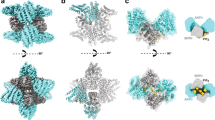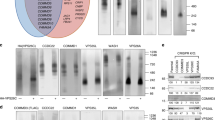Abstract
Several SH3-domain-containing proteins have been implicated in endocytosis by virtue of their interactions with dynamin; however, their functions remain undefined. Here we report the efficient reconstitution of ATP-, GTP-, cytosol- and dynamin-dependent formation of clathrin-coated vesicles in permeabilized 3T3-L1 cells. The SH3 domains of intersectin, endophilin I, syndapin I and amphiphysin II inhibit coated-vesicle formation in vitro through interactions with membrane-associated proteins. Most of the SH3 domains tested selectively inhibit late events involving membrane fission, but the SH3A domain of intersectin uniquely inhibits intermediate events leading to the formation of constricted coated pits. These results suggest that interactions between SH3 domains and their partners function sequentially in endocytic coated-vesicle formation.
This is a preview of subscription content, access via your institution
Access options
Subscribe to this journal
Receive 12 print issues and online access
$209.00 per year
only $17.42 per issue
Buy this article
- Purchase on Springer Link
- Instant access to full article PDF
Prices may be subject to local taxes which are calculated during checkout






Similar content being viewed by others
References
Schmid, S. L., McNiven, M. A. & De Camilli, P. Dynamin and its partners: a progress report. Curr. Opin. Cell Biol. 10, 504–512 (1998).
Sever, S., Muhlberg, A. B. & Schmid, S. L. Impairment of dynamin’s GAP domain stimulates receptor-mediated endocytosis. Nature 398, 481–486 (1999).
David, C., McPherson, P. S., Mundigl, O. & deCamilli, P. A. Role of amphiphysin in synaptic vesicle endocytosis suggested by its binding to dynamin in nerve terminals. Proc.Natl Acad. Sci. USA 93, 331–335 (1996).
Leprince, C. et al. A new member of the amphiphysin family connecting endocytosis and signal transduction pathways. J. Biol. Chem. 272 , 15101–15105 (1997).
Ramjaun, A. R., Micheva, K. D., Bouchelet, I. & McPherson, P. S. Identification and characterization of a nerve terminal-enriched amphiphysin isoform. J. Biol. Chem. 272, 16700– 16706 (1997).
de Heuvel, E. et al.Identification of the major synaptojanin-binding proteins in brain. J. Biol.Chem. 272, 8710– 8716 (1997).
Ringstad, N., Nemoto, Y. & De Camilli, P. The SH3p4/Sh3p8/SH3p13 protein family: binding partners for synaptojanin and dynamin via a Grb2-like Src homology 3 domain. Proc.Natl Acad. Sci. USA 94, 8569– 8574 (1997).
Roos, J. & Kelly, R. B. Dap160, a neural-specific eps15 homology and multiple SH3 domain-containing protein that interacts with Drosophila dynamin. J. Biol.Chem. 273, 19108–19119 (1998).
Yamabhai, M. et al. Intersectin, a novel adaptor protein with two eps15 homology and five src homology3 domains. J. Biol. Chem. 273, 31401–31407 (1998).
Senger, A. S., Wang, W., Bishay, J., Cohen, S. & Egan, S. E. The EH and SH3 domain Ese proteins regulate endocytosis by linking to dynamin and Eps15. EMBO J. 18, 1159–1171 (1999).
Qualmann, B., Roos, J., DiGregorio, P. J. & Kelly, R. B. Syndapin I, a synaptic dynamin-binding protein that associates with the neural Wiskott-Aldrich syndrome protein. Mol. Biol.Cell 10 , 501–513 (1999).
Gout, I. et al.The GTPase dynamin binds to and is activated by a subset of SH3 domains. Cell 75, 25–36 (1993).
McPherson, P. S. et al.A presynaptic inositol 5 phosphatase. Nature 379, 353–357 (1996).
McPherson, P. S. et al.Interaction of Grb2 via its Src homology 3 domains with synaptic proteins including synapsin I. Proc. Natl Acad. Sci. USA 91, 6486–6490 (1994).
Wigge, P. & McMahon, H. T. The amphiphysin family of proteins and their role in endocytosis at the synapse. Trends Neurosci. 21 339–344 ( 1998).
Shupliakov, O. et al.Synaptic vesicle endocytosis impaired by disruption of dynamin-SH3 domain interactions. Science 276, 259– 263 (1997).
Wigge, P., Vallis, Y. & McMahon, H. T. Inhibition of receptor-mediated endocytosis by the amphiphysin SH3 domain. Curr. Biol. 7, 554 –560 (1997).
Di Fiore, P. P., Pelicci, P. G. & Sorkin, A. EH: a novel protein-protein interaction domain potentially involved in intracellular sorting. Trends Biochem. Sci. 22, 411–413 (1997).
Hussain, N. K. et al. Splice variants of intersectin are components of the endocytic machinery in neurons and non-neuronal cells. J. Biol. Chem. 274, 15671–15677 (1999).
Mahaffey, D. T., Moore, M. S., Brodsky, F. M. & Anderson, R. G. W. Coat proteins isolated from clathrin coated vesicles can assemble into coated pits. J. Cell Biol. 108, 1615– 1624 (1989).
Lin, H. C., Moore, M. S., Sanan, D. A. & Anderson, R. G. W. Reconstitution of clathrin-coated pit budding from plasma membranes. J. Cell Biol. 114, 881–891 (1991).
Gilbert, A., Paccaud, J. P. & Carpentier, J. L. Direct measurement of clathrin-coated vesicle formation using a cell-free assay. J. Cell Sci. 110, 3105–3115 (1997).
Schmid, S. L. & Smythe, E. Stage-specific assays for coated pit formation and coated vesicle budding invitro. J. Cell Biol. 114, 869–880 ( 1991).
Smythe, E., Carter, L. L. & Schmid, S. L. Cytosol- and clathrin-dependent stimulation of endocytosis invitro by purified adaptors. J. Cell Biol. 119 , 1163–1171 (1992).
Schmid, S. L. Clathrin-coated vesicle formation and protein sorting: An integrated process . Annu. Rev. Biochem. 66, 511– 548 (1997).
Orci, L. et al.Budding from Golgi membranes requires the coatomer complex of non-clathrin coat proteins. Nature 362, 648–652 (1993).
Barlowe, C. et al.COPII: A membrane coat formed by Sec proteins that drive vesicle budding from the endoplasmic reticulum. Cell 77, 895–907 (1994).
Damke, H., Baba, T., Warnock, D. E. & Schmid, S. L. Induction of mutant dynamin specifically blocks endocytic coated vesicle formation. J. Cell Biol. 127, 915–934 (1994).
Oh, P., McIntosh, D. P. & Schnitzer, J. E. Dynamin at the neck of caveolae mediates their budding to form transport vesicles by GTP-driven fission from the plasma membrane of endothelium. J. Cell Biol. 141, 101– 114 (1998).
Ostermann, J. et al. Stepwise assembly of functionally active transport vesicles . Cell 75, 1015–1025 (1993).
Rowe, T. et al. COPII vesicles derived from mammalian endoplasmic reticulum (ER) microsomes recruit COP1. J.Cell Biol. 135, 895–911 (1996).
Jost, M., Simpson, F., Kavran, J. M., Lemmon, M. A. & Schmid, S. L. Phosphatidylinositol-4,5-bisphosphate is required for endocytic coated vesicle formation. Curr. Biol. 8, 1399–1402 ( 1998).
Achiriloaie, M., Barylko, B. & Albenesi, J. P. Essential role of the dynamin pleckstrin homology domain in receptor-mediated endocytosis. Mol. Cell Biol. 19, 1410–1415 (1999).
Lee, A., Frank, D. W., Marks, M. S. & Lemmon, M. A. Dominant-negative inhibition of receptor-mediated endocytosis by a dynamin-1 mutant with a defective pleckstrin homology domain. Curr. Biol. 9, 261–264 ( 1999).
Vallis, Y., Wigge, P., Marks, B., Evans, P. R. & McMahon, H. T. Importance of the pleckstrin homology domain of dynamin in clathrin-mediated endocytosis. Curr. Biol. 9, 257–260 (1999).
Carter, L. L., Redelmeier, T. E., Woolenweber, L. A. & Schmid, S. L. Multiple GTP-binding proteins participate in clathrin-coated vesicle-mediated endocytosis. J. Cell Biol. 120, 37– 45 (1993).
Micheva, K. D., Kay, B. K. & McPherson, P. S. Synaptojanin forms two separate complexes in the nerve terminal. Interactions with endophilin and amphiphysin. J. Biol. Chem. 272, 27239–27245 (1997).
Wang, Z. & Moran, M. F. Requirement for the adapter protein GRB2 in EGF receptor endocytosis. Science 272, 1935–1939 (1996).
Sparks, A. B. et al.Distinct ligand preferences of Src homology 3 domains from Src, Yes, Abl, Cortactin, p53bp2, PLCg, Crk, and Grb2. Proc. Natl Acad. Sci. USA 93, 1540–1544 (1996).
Robinson, P. J. et al. Dynamin GTPase regulated by protein kinase C phosphorylation in nerve terminals. Nature 365, 163– 166 (1993).
Lamaze, C., Baba, T., Redelmeier, T. E. & Schmid, S. L. Recruitment of epidermal growth factor receptor and transferrin receptors into coated pits in vitro: differing biochemical requirements. Mol. Biol. Cell 3, 1181–1194 (1993).
Schmid, S. L. & Carter, L. L. ATP is required for receptor-mediated endocytosis in intact cells. J.Cell Biol. 111, 2307–2318 (1990).
Heuser, J. E. & Reese, T. S. Evidence for recycling of synaptic vesicle membrane during transmitter release at the frog neuromuscular junction . J. Cell Biol. 57, 315– 344 (1973).
Estes, P. S. et al. Traffic of dynamin within individual Drosophila synaptic boutons relative to compartment specific markers. J. Neurosci. 16, 5443–5456 ( 1996).
Gaidarov, I., Santini, F., Warren, R. A. & Keen, J. H. Spatial control of coated pit dynamics in living cells. Nature Cell Biol. 1, 1–7 ( 1999).
Micheva, K. D., Ramjaun, A. R., Kay, B. K. & McPherson, P. S. SH3 domain-dependent interactions of endophilin with amphiphysin. FEBS Lett. 414, 308–312 (1997).
Warnock, D. E., Terlecky, L. J. & Schmid, S. L. Dynamin GTPase is stimulated by crosslinking through the C-terminal proline-rich domain. EMBO J. 14, 1322–1328 (1995).
Harlow, E. & Lane, D. Antibodies: A Laboratory Manual (Cold Spring Harbor Publications, Cold SpringHarbor, 1988 ).
Warnock, D. E., Baba, T. & Schmid, S. L. Ubiquitously expressed dynamin-II has a higher intrinsic GTPase activity and a greater propensity for self-assembly than neuronaldynamin-I . Mol. Biol. Cell 8, 2553– 2562 (1997).
Muhlberg, A. B., Warnock, D. E. & Schmid, S. L. Domain structure and intramolecular regulation of dynamin GTPase. EMBO J. 16, 6676– 6683 (1997).
Acknowledgements
We thank J. Philie, E. De Heuvel and M. Yamabhai for providing reagents; M. Jost for critical reading of the manuscript; and W. Sossin for advice and support (to P.S.M.). The work was supported by grants from the NIH (S.L.S, R.B.K.) and the Natural Sciences and Engineering Research Council (P.S.M.) and by the University of Wisconsin Madison Medical School (B.K.K.). F.S. is supported by a Wellcome Trust Fellowship and B.Q by a postdoctoral fellowship from the Deutsche Forschungsgemeinschaft. S.L.S. is an Established Investigator of the American Heart Association and P.S.M. is a Scholar of the Medical Research Council of Canada and an Alfred P. Sloan Research Fellow.
Correspondence and requests for materials should be addressed to P.S.M or S.L.S.
Author information
Authors and Affiliations
Rights and permissions
About this article
Cite this article
Simpson, F., Hussain, N., Qualmann, B. et al. SH3-domain-containing proteins function at distinct steps in clathrin-coated vesicle formation. Nat Cell Biol 1, 119–124 (1999). https://doi.org/10.1038/10091
Received:
Revised:
Accepted:
Published:
Issue Date:
DOI: https://doi.org/10.1038/10091
This article is cited by
-
Inositol hexakisphosphate primes syndapin I/PACSIN 1 activation in endocytosis
Cellular and Molecular Life Sciences (2022)
-
TMEM16F and dynamins control expansive plasma membrane reservoirs
Nature Communications (2021)
-
MACC1 regulates clathrin-mediated endocytosis and receptor recycling of transferrin receptor and EGFR in colorectal cancer
Cellular and Molecular Life Sciences (2021)
-
Endophilin-A coordinates priming and fusion of neurosecretory vesicles via intersectin
Nature Communications (2020)
-
Functional recruitment of dynamin requires multimeric interactions for efficient endocytosis
Nature Communications (2019)



